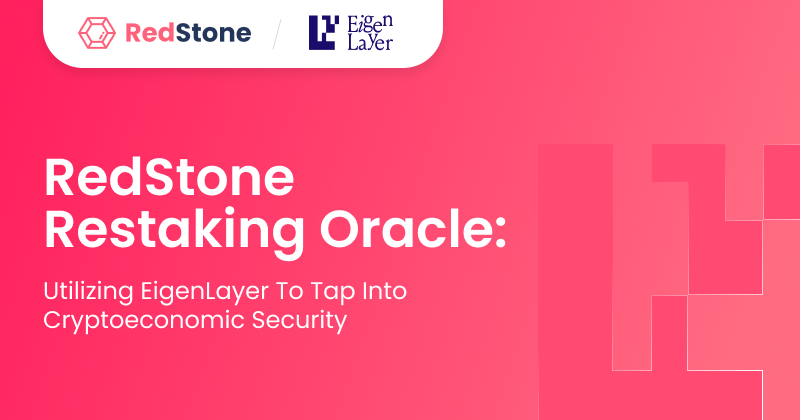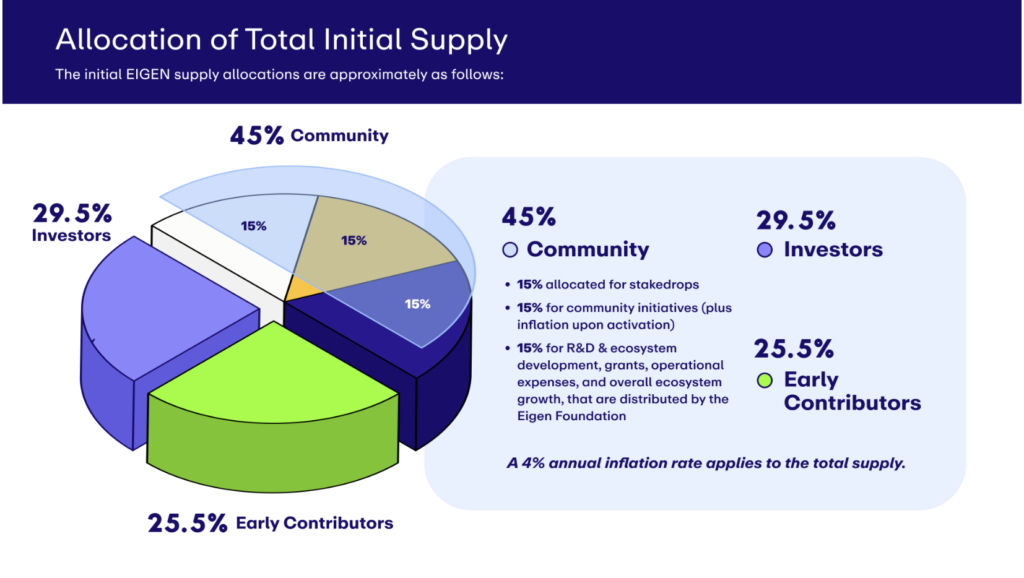Dive into the importance of restaking for oracles and how RedStone expands its capabilities with EigenLayer.

RedStone: The Fastest Growing Oracle In 2024
Oracles are responsible for delivering data feeds to blockchains and protocols that utilize them for the secure execution of smart contracts. The two most popular models on the market are the Push and the Pull models. Thanks to its modular design, RedStone is the only oracle supporting both of these models cross-chain. At the same time, the bespoke price discovery mechanism allowed to lead the Liquid Staking and Liquid Restaking sector making RedStone the go-to-partner for projects issuing yield-bearing assets like Ether.fi, Puffer, Renzo or Lombard. All of that resulted in stellar growth of RedStone from $400M Total Value Secured at the beginning of 2024 to about $4 Billion (1,250% growth YTD) and from 20 to 100+ clients.
RedStone identifies four key modules in its architecture, each responsible for:
- Sourcing Module – identifying whitelisted sources of data feeds,
- Node Operators Module – fetching data from sources and transmitting to DDL,
- Data Aggregation Module – combining signed packages off-chain or on-chain,
- Data Consumption Module – delivery of data to end user in Pull, Push and other models.
Whereas the benefits of restaking can be leveraged in multiple parts of the flow, the most capital-intensive value driver lies in incorporating restaked security and operators in the Data Aggregation Module.
Why Would An Oracle Use Restaking?
One of the biggest challenges of an oracle is a scenario, where the cumulative size and value of protected systems is bigger than the one of the oracle in question. If $100 Billion of total value is protected by an oracle system, whose security is based on i.e. $1 Billion worth of staking of the native oracle token, then a sophisticated party could construct an attack to profitably extract value from the system. The All-Time High Total Value Locked in DeFi of $300 Billion was reached in December 2021. Currently, it sits at about $165 Billion and oracle systems should be able to adjust the value of their cryptoeconomic security based on the size of the protected market.
EigenLayer offers an opportunity to leverage restaking and scale up or down the value of assets protecting an oracle system based on ongoing needs. Practically speaking, there are three major benefits of embedding EigenLayer AVS in an oracle system.
Firstly, the architecture has been meticulously designed and audited to serve as a universal layer for restaking, rather than being tailored to just one protocol’s specific use case. It’s also significantly more competitive and faster to build on top of a universal framework than to set up your own system from scratch.
Secondly, it offers flexibility based on the market maturity of the oracle network. An early-stage player doesn’t need a large amount of restaked security, as it carries the high cost of paying rewards to restakers. Therefore, the system supports a healthy, gradual increase in shared security consumption, aligning with the successful growth of an oracle and the increasing value of protected assets.
Thirdly, EigenLayer opens an opportunity to utilise a diverse basket of assets as restaked collateral, i.e. native oracle token, ETH, LSTs, but also stablecoins and BTC. Also, it adds a standardised procedure for onboarding operators, which makes the life of new AVSes and projects utilizing restaked security much easier.
RedStone AVS On EigenLayer
RedStone AVS is a pioneering solution that utilizes the concept of restaking to create a decentralized process for delivering price data in Pull and Push oracle models. The system is built on the Othentic AVS development framework, ensuring that the price feeds are both reliable and secure. Othentic Stack orchestrates low-level AVS development, where underlying complexities around consensus, Operators, networking, messaging, and attestations are abstracted away, allowing RedStone to focus on core products and accelerate time-to-market.
The process begins with the collection of data feeds from the Node Operators Module. These collected data points are then subjected to a series of verifications, including checks for accuracy, consistency, and the validity of digital signatures. Once the data passes these initial built-in examinations, the median price and the corresponding timestamp are calculated from the gathered information. This calculated result is then verified by the AVS operators. If the operators confirm the correctness of the result, it is subsequently transmitted to the blockchain.
The AVS operates through several key components, each playing a crucial role in the validation and aggregation process:
- Task Performer – fetches data from multiple oracle nodes, then verifies the retrieved data for correctness, consistency, and proper signing,
- Aggregator – acts as a central point, receiving results computed by the Task Performer. These results are sent to a pool of Attesters, who registered through the Aggregator.
- Attester – are responsible for verifying the result calculated by the Task Performer and casting a vote either in favour or against based on this verification. Each such vote must be signed by the Attester
- Validation API – is an automatic service that verifies the accuracy of the result calculated by the Task Performer.
- Smart contracts – After being verified by Attesters, the Task Performer’s result is sent to the blockchain. Smart contracts do not need to re-verify the received data. It is sufficient for them to check if the data has been signed by a sufficient number of Attesters.
The broader description of the AVS system can be found in RedStone Documentation.
In this flow, AVS acts as a mechanism to identify and keep account of any potentially fraudulent nodes attempting to update an incorrect price feed. An important aspect to take into consideration is the cost of updates and signatures verification. This system is designed for use cases that can tolerate lower update frequencies but protect high-value assets, such as lending or CDP protocols.

What’s Next For RedStone’s Expansion In Restaking?
On the 30th of September 2024, the EIGEN token became transferrable, opening a new chapter for EigenLayer’s expansion. The innovative initial distribution, with liquidity unlocked over two seasons of stakedrop, rewarded early restakers as well as many creators and developers contributing to the EigenLayer flywheel. The system is almost fully complete, now awaiting the slashing implementation. RedStone is dedicated to continuous research on the optimal implementation of restaking in the oracle flow. As of October, the testnet implementation of RedStone AVS is undergoing security audits, awaiting feedback from multiple security experts. The testnet implementation successfully executes the end-to-end data delivery pipeline on Polygon zkEVM and Arbitrum L2s. In the coming months, the team will continue the expansion of the implementation, improving the costs of operating the AVS on Ethereum Mainnet. It is envisioned that the AVS will adopt a dual token model, enabling participants to derive cryptoeconomic security from both ETH’s Liquid Staking Tokens (LSTs) and the RedStone Token.
The RedStone Token is expected to launch in the coming months alongside the EigenLayer slashing mechanism allowing for a gradual rollout of the AVS itself. In the meantime, the RedStone team is focusing on expanding oracle usage and refining the best use cases for the restaking flow.
RedStone is the fastest-growing modular oracle delivering diverse, high-frequency data feeds to EVM Layer1, Layer2, Rollup-as-a-Service networks, and beyond now securing over 5 billion of assets in the industry. For more information about liquid staking and liquid restaking, check out our report on staking.
